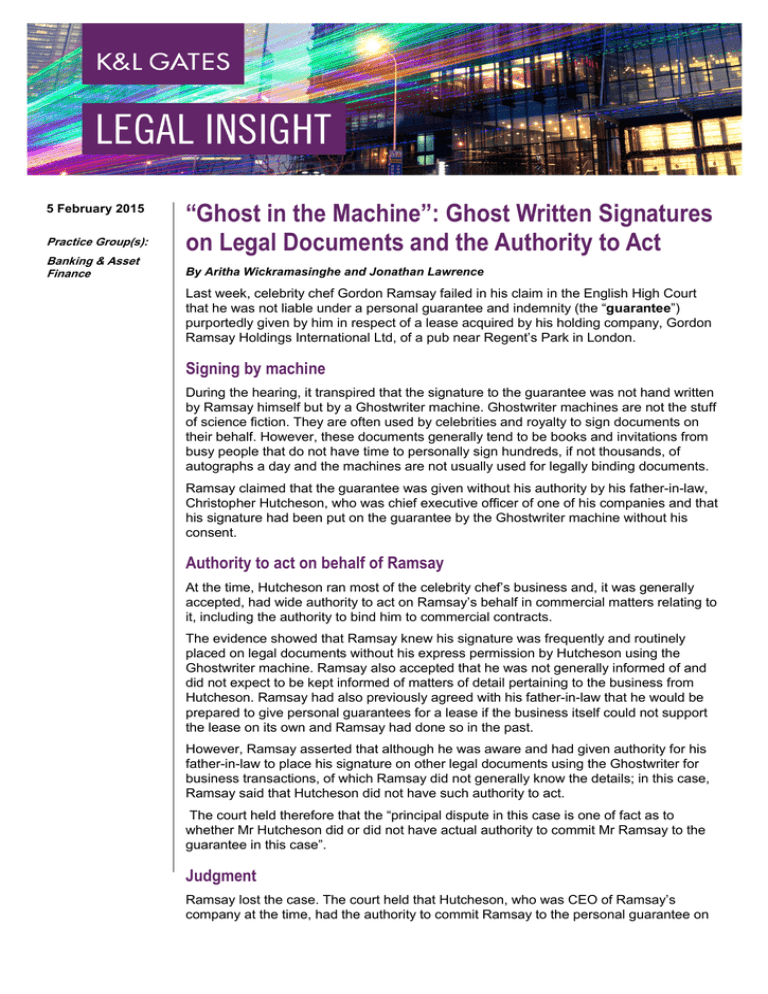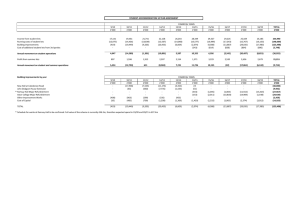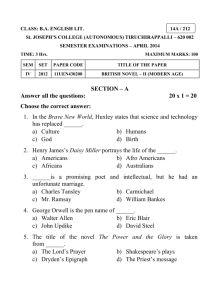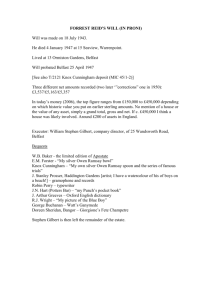
5 February 2015
Practice Group(s):
Banking & Asset
Finance
“Ghost in the Machine”: Ghost Written Signatures
on Legal Documents and the Authority to Act
By Aritha Wickramasinghe and Jonathan Lawrence
Last week, celebrity chef Gordon Ramsay failed in his claim in the English High Court
that he was not liable under a personal guarantee and indemnity (the “guarantee”)
purportedly given by him in respect of a lease acquired by his holding company, Gordon
Ramsay Holdings International Ltd, of a pub near Regent’s Park in London.
Signing by machine
During the hearing, it transpired that the signature to the guarantee was not hand written
by Ramsay himself but by a Ghostwriter machine. Ghostwriter machines are not the stuff
of science fiction. They are often used by celebrities and royalty to sign documents on
their behalf. However, these documents generally tend to be books and invitations from
busy people that do not have time to personally sign hundreds, if not thousands, of
autographs a day and the machines are not usually used for legally binding documents.
Ramsay claimed that the guarantee was given without his authority by his father-in-law,
Christopher Hutcheson, who was chief executive officer of one of his companies and that
his signature had been put on the guarantee by the Ghostwriter machine without his
consent.
Authority to act on behalf of Ramsay
At the time, Hutcheson ran most of the celebrity chef’s business and, it was generally
accepted, had wide authority to act on Ramsay’s behalf in commercial matters relating to
it, including the authority to bind him to commercial contracts.
The evidence showed that Ramsay knew his signature was frequently and routinely
placed on legal documents without his express permission by Hutcheson using the
Ghostwriter machine. Ramsay also accepted that he was not generally informed of and
did not expect to be kept informed of matters of detail pertaining to the business from
Hutcheson. Ramsay had also previously agreed with his father-in-law that he would be
prepared to give personal guarantees for a lease if the business itself could not support
the lease on its own and Ramsay had done so in the past.
However, Ramsay asserted that although he was aware and had given authority for his
father-in-law to place his signature on other legal documents using the Ghostwriter for
business transactions, of which Ramsay did not generally know the details; in this case,
Ramsay said that Hutcheson did not have such authority to act.
The court held therefore that the “principal dispute in this case is one of fact as to
whether Mr Hutcheson did or did not have actual authority to commit Mr Ramsay to the
guarantee in this case”.
Judgment
Ramsay lost the case. The court held that Hutcheson, who was CEO of Ramsay’s
company at the time, had the authority to commit Ramsay to the personal guarantee on
“Ghost in the Machine”: Ghost Written Signatures on
Legal Documents and the Authority to Act
his behalf. The court found that Hutcheson did not have any limitation on his general
authority to act on behalf of the business and had Ramsay’s authority to put his signature
on legal documents as a director of the business. The court further found that although
Hutcheson’s wide authority was to act on behalf of the business, the personal guarantee
in this regard was not a non-business matter since it was required in order to acquire the
leases which Ramsay himself was very keen to do.
Implications
Can a ghost signature be effective?
Yes. The court held that for the purpose of signing a document (and, in particular, a
deed) creating a guarantee, the guarantor does not need to hold the pen in his hand to
sign the document. Therefore, it seems a ghost writing machine can effectively sign a
document.
With the increased use of counterparts and electronic signings, there is a risk that
documents may be signed by machines rather than the actual persons by hand,
without the awareness of the other parties. The Ghostwriters in this case used
pens that gave the appearance of a pen with a fine nib being used. When receiving
a signed document, one would generally compare the signatures placed on the
signed documents, note that it looks as if the signatures were placed by a pen (and
is therefore an original document) and compare the signatures to the list of
authorised signatories and their specimen signatures to determine their
authenticity. This judgment indicates that it would not be necessary to confirm that
such signatures were also placed on that document by the own hand of the
signatory to create a binding obligation on the party whose signature appears on
that document.
Judgment excerpts [paragraph 7]:
“It was accepted that for the purpose of signing a document (and, in particular, a deed)
creating a guarantee, it was not necessary that the guarantor should sign the document
with a pen held in his own hand. It was accepted that if Mr Ramsay had himself operated
the signature writing machine to place his signature on the deed, then the deed would
have been effectively signed by him. Similarly, it was accepted that if Mr Ramsay had
expressly authorised another person to operate the signature writing machine to
place Mr Ramsay’s signature on the deed, then the deed would have been
effectively signed by Mr Ramsay.
Section 1(3) of the Law of Property (Miscellaneous Provisions) Act 1989 states that a
deed must be “signed” by an executing party. There are statements in the authorities
which suggest that a document is only “signed” by an executing party when he signs it
with a pen in his own hand: see Firstpost Homes Ltd v Johnson [1995] 1 WLR 1567 at
1575 and 1577, citing Goodman v J Eban Ltd [1954] 1 QB 550 at 555 and 561. However,
those statements were not designed to distinguish between signing by use of a pen held
in the executing party’s hand as distinct from the use of a signature writing machine.
Further, no point was taken as to the requirement in section 1(3) of the 1989 Act that the
deed be signed by the executing party in the presence of an attesting witness.
In any case, a guarantee can be entered into otherwise than by deed. Initially, counsel for
Mr Ramsay did refer to section 4 of the Statute of Frauds Act 1677, which states that a
guarantee must be evidenced in writing by a document which is “signed” by or on behalf
of the guarantor and some point was sought to be made about the application of section
4. However, it was pointed out that the disputed “guarantee” in this case was a guarantee
2
“Ghost in the Machine”: Ghost Written Signatures on
Legal Documents and the Authority to Act
and indemnity and that it has long been established that section 4 did not apply to a
contract of indemnity (see Chitty on Contracts, 31st ed., paragraph 44-043), so any
possible point under section 4 fell away. At this point, I should explain that I will for
convenience in this judgment refer to the disputed obligation in this case as “a guarantee”
even though, more technically, it is a contract of indemnity.”
Execution of a Guarantee as opposed to a Guarantee and Indemnity
The court re-affirmed the distinction between the execution methods to be adopted when
executing a standalone guarantee as opposed to a guarantee and indemnity. Most
commercially drafted guarantees (for example, in facility agreements) are drafted as a
combined guarantee and indemnity.
The court held that the execution of a standalone guarantee (without indemnity) would be
governed under s4 of the Statute of Frauds Act 1677, which states that “a guarantee
must be evidenced in writing by a document which is “signed” by or on behalf of the
guarantor”. However, where the “guarantee” is an indemnity, as was in this case, s4 of
the 1677 Act does not apply (see Chitty on Contracts, 31st ed., paragraph 44-043).
A guarantee can effectively be created and validly signed in accordance with s4 of the
1677 Act by writing your name at the end of an email confirming the terms of that
guarantee (see Golden Ocean Group Ltd v Salgaocar Mining Industries PVT Ltd [2012]
EWCA Civ 265) .
Authority of agents
This case also highlights the importance of clearly setting out what agents can and
cannot do. Any powers of attorney or other documents granting authority to any
person to act as agent should be carefully reviewed and limitations should be
clearly set out. It may also be relevant to consider whether any specific reference
should be made in such documents to methods of execution of documents and the
use of ghost writing machines to create binding legal contracts.
Case citation: Gordon James Ramsay v Gary Love [2015] EWHC 65 (Ch)
3
“Ghost in the Machine”: Ghost Written Signatures on
Legal Documents and the Authority to Act
Authors:
Aritha Wickramasinghe
aritha.wickramasinghe@klgates.com
+44.(0)20.7360.8185
Jonathan Lawrence
jonathan.lawrence@klgates.com
+44.(0)20.7360.8242
Anchorage Austin Beijing Berlin Boston Brisbane Brussels Charleston Charlotte Chicago Dallas Doha Dubai Fort Worth Frankfurt
Harrisburg Hong Kong Houston London Los Angeles Melbourne Miami Milan Moscow Newark New York Orange County Palo Alto
Paris Perth Pittsburgh Portland Raleigh Research Triangle Park San Francisco São Paulo Seattle Seoul Shanghai Singapore
Spokane Sydney Taipei Tokyo Warsaw Washington, D.C. Wilmington
K&L Gates comprises more than 2,000 lawyers globally who practice in fully integrated offices located on five
continents. The firm represents leading multinational corporations, growth and middle-market companies,
capital markets participants and entrepreneurs in every major industry group as well as public sector entities,
educational institutions, philanthropic organizations and individuals. For more information about K&L Gates or
its locations, practices and registrations, visit www.klgates.com.
This publication is for informational purposes and does not contain or convey legal advice. The information herein should not be used or relied upon
in regard to any particular facts or circumstances without first consulting a lawyer.
© 2015 K&L Gates LLP. All Rights Reserved.
4



